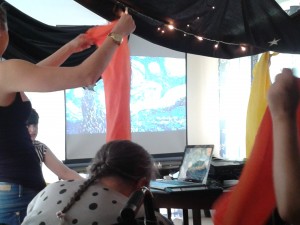Andy Miles led us masterfully through some of the findings on cultural consumption around ageing, bringing to the fore the importance of participation per se – his interrogation of official and unofficial cultural practices is something that ties in with our New Dynamics of Ageing work. He then looked at an interesting case study involving both a settled and incoming population and their approach to formalizing a resilience strategy. Questions were raised about who would take over in subsequent generations.
Karen Scott interrogated some of the governmental responses to wellbeing and resilience, noting the limits and indefensible application of the positive psychology movement’s five-point-star-jump plans to the objectively challenging circumstances individuals face.
Everyone wanted to know what was in Michael Eades’s ‘Festival in a Box’ – why, a cornucopia of revolutionary ideas, people! Michael analysed some of his data to think about everyday resilience and it seemed the biggest shift was in the attitudes and understandings of the artist facilitators around dementia.
Phil Jones took on Karen’s baton by jumping into his Cultural Intermediation work. We were impressed by his app that allows people to comment on their surroundings and how they might be changed. He also brought in some of the challenges of what to do with false narratives (the collective stories people tell about a business closing which might reinforce wider narratives around immigration and community change) and some of the everyday challenges of getting data, for example, male tour guides accompanying Muslim women.
Andy Newman talked us through the way different groups had made sense of the contemporary art they saw in our New Dynamics of Ageing project and dealt with the difficult question of whether the art generated social connections or whether social connections enabled people to access the art.
I talked about the gaps in existing resilience research and how this married with my own conversations with older people (for example, the importance of everyday rituals such as learning to cook for yourself as a widower and the motivational challenge involved in ‘simply’ joining a club – see Karen’s five-point plan). I uncontroversially called for a more subtle conceptualization of the relationship between individual and community resilience and argued that the focus on individual characteristics only helps people beats the odds, rather than remove the odds that put people at risk in the first place. Still very unsure of whether our creative interventions help people thrive – is survival/coping a more realistic aim?

